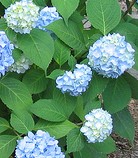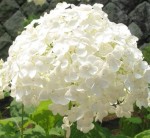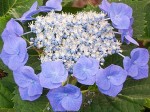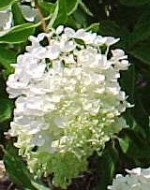
The large flowerheads of hydrangea bring an old fashioned charm to a garden. The flowers may be white, pink, blue, or a shade of purple, they can be round or cone-shaped, and made up of one kind of flower or two. The leaves are large and handsome, setting off the flowers to advantage as they bloom and fade. The variations in hydrangeas are considerable and are important when selecting hydrangea bushes for the garden.
There are four basic types of hydrangea found in nurseries and catalogs today. They differ in appearance as well as in requirements for good growth.
 Hydrangea arborescens grandiflora
Hydrangea arborescens grandiflora
 Growing only about 3’ tall, this hydrangea is dense, upright, and has large, ball-shaped, creamy white flowerheads 10” or more across in early summer. It blooms on the current year’s growth so can be severely pruned and still produce flowers. They are hardy to USDA zone 4 and do well in part shade. The most common cultivar available has been ‘Annabelle’ but some new varieties have been developed and are coming on the market.
Growing only about 3’ tall, this hydrangea is dense, upright, and has large, ball-shaped, creamy white flowerheads 10” or more across in early summer. It blooms on the current year’s growth so can be severely pruned and still produce flowers. They are hardy to USDA zone 4 and do well in part shade. The most common cultivar available has been ‘Annabelle’ but some new varieties have been developed and are coming on the market.
For more on ‘Annabelle’ see my plant profile.
 Hydrangea macrophylla
Hydrangea macrophylla

The flowerheads of H. macrophylla come in two forms: mopheads with flowers all of one kind, and lacecap with small flowers in the center surrounded by larger flowers. Both kinds can be pink or blue depending on the pH of the soil; in alkaline soil, the flowers tend to be pink, while in acidic soils flowers tend to be blue to purple. Some varieties tend to be more blue or more pink than others. White varieties are available but are not as common as the pink or blue ones and do not change color. H. macrophylla can be 12’ tall, prefer part shade, and are hardy to USDA zone 5-6 so can not be grown out doors in northern climates where they are often grown as houseplants. The flowers form on old growth so winter kill or pruning can eliminate flower buds and result in a bush with no flowers. New varieties such as those in the Endless Summer series bloom on new and old growth and therefore rebloom in the course of the summer.
 Hydrangea paniculata
Hydrangea paniculata
 These hydrangeas are coarse in texture and can be up to 25’ tall. The white flowers are borne in long pyramidal clusters (panicles) in late summer and gradually take on a pink to purplish color as they age. Hardy to USDA zone 4, Hydrangea paniculata needs some sun to bloom well. It can be pruned any time except when buds are forming and is the only kind hydrangea that can be pruned into a tree. Peegee hydrangea is the most common variety, getting its name from its specific and varietal name, H. paniculata ‘Grandiflora’, but ‘Limelight’ is becoming more common and popular every year with its bright chartreuse color.
These hydrangeas are coarse in texture and can be up to 25’ tall. The white flowers are borne in long pyramidal clusters (panicles) in late summer and gradually take on a pink to purplish color as they age. Hardy to USDA zone 4, Hydrangea paniculata needs some sun to bloom well. It can be pruned any time except when buds are forming and is the only kind hydrangea that can be pruned into a tree. Peegee hydrangea is the most common variety, getting its name from its specific and varietal name, H. paniculata ‘Grandiflora’, but ‘Limelight’ is becoming more common and popular every year with its bright chartreuse color.
 Hydrangea quercifolia (Oakleaf Hydrangea)
Hydrangea quercifolia (Oakleaf Hydrangea)
 The creamy white flowers are produced on erect panicles 4-8” long earlier in the summer than the other hydrangeas. The leaves of this 6’ tall bush resemble those of a red oak, hence the specific name quercifolia, and turn shades of red, orange, and yellow in the fall. It is hardy to USDA zone 5 and is sometimes grown in northern areas just for the fall coloration it provides. Compared to other hydrangeas it can tolerate drier soil but may succumb to root rot quickly if grown in poorly drained soils.
The creamy white flowers are produced on erect panicles 4-8” long earlier in the summer than the other hydrangeas. The leaves of this 6’ tall bush resemble those of a red oak, hence the specific name quercifolia, and turn shades of red, orange, and yellow in the fall. It is hardy to USDA zone 5 and is sometimes grown in northern areas just for the fall coloration it provides. Compared to other hydrangeas it can tolerate drier soil but may succumb to root rot quickly if grown in poorly drained soils.
When choosing a hydrangea for the garden color is probably the first characteristic that comes to mind so if you want pink or blue you better live in a region warmer than USDA zone 6. For fall coloration, oak leaf hydrangea is the one to pick; for a tree-like form, choose H. paniculata; if the space is small try H. arborescens or plan to prune. For a sunny spot H. paniculata will probably fare best; for a dry spot, H. quercifolia. Whatever hydrangea you choose, it will provide a spectacular display of flowers at a time when few other shrubs are blooming.